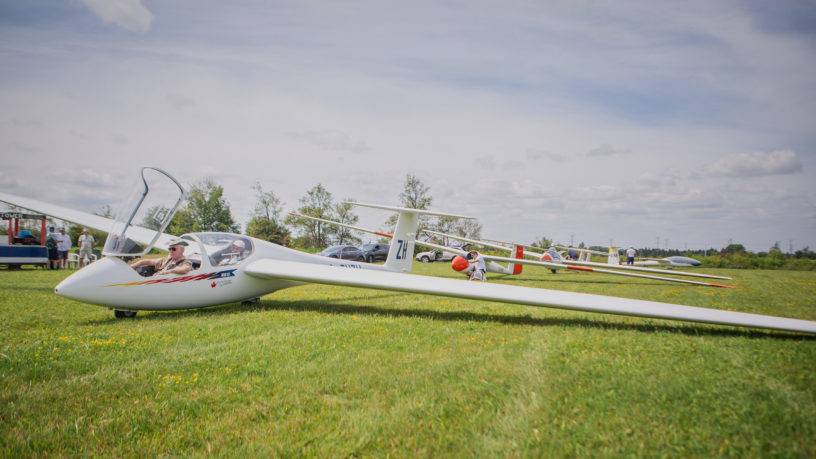By Nalyn Tindall
Soaring high above the clouds has been a dream for many, but the high cost of flying education has often acted as an insurmountable barrier for students. However, at Toronto Metropolitan University (TMU), a new initiative is taking flight—the University Soaring Society (USS). Thanks to founder Mike Morgulis, a flying instructor at the Toronto Soaring Club, the sky is now open to students like never before.
According to the USS president Joel Derrick Navaratnam, a fourth-year aerospace engineering student, TMU is a “trailblazer” in the world of varsity aviation as there are currently no other university soaring clubs in Canada. Navaratnam said that unlike universities in other countries such as Japan and Germany where gliding is highly popular, most Canadian institutions tend to prioritize commercial flying or general aviation.
Gliding is already far more affordable than commercial flying, which can cost aspiring pilots up to $15,000, according to the Canada Aviation Academy. With an already significantly lower rate of $3,000 to $4,000 estimated by the Toronto Soaring Club to earn a glider license without financial support, gliding becomes an attainable dream for students with a passion for recreational aviation.
Lester Pinlac, a fifth-year aerospace engineering student and USS operations director said the group aims to provide opportunities for students to explore the world of gliding barrier-free. He said his involvement in the club was born out of his passion for flying after years as a Royal Canadian Air Cadet. Pinlac is aiming to not only make soaring accessible but also nurture a diverse community of students eager to embrace this exhilarating sport. “We just want to bring glidng on a more accessible scale,” he said.
The USS has a relatively low-cost barrier to entry. The cost of entry into the sport has significantly decreased due to strategic collaborations with organizations like the Youth Flight Canada Education Fund (YFC) and the Toronto Soaring Club. These partnerships provide aspiring glider pilots with invaluable resources and scholarships to help them work towards their glider licenses.
According to Navaratnam, YFC offers eligible USS members a generous initial funding of $500 towards their tow fees and membership costs. Throughout their flying journey, members can gain additional funding to support their education.
The charity also provides a free, gold-standard training glider for USS members to use, along with a flight simulator located on campus that allows students to practice their craft whenever they want. Through the contributions of YFC, the price of gliding is severely decreased.
The Toronto Soaring Club, based in Southgate, Ont., offers the USS an airfield for conducting operations, volunteer ground school and flight instructors. This collaboration allows students to receive top-notch education, training and guidance from experienced professionals without any additional financial burden.
Morgulis said that being a gliding instructor is “the best feeling in the world” and the reason he volunteers. “It’s a sense of accomplishment when your students succeed and it’s even better when your students surpass you,” he said.
Earning a glider pilot’s license typically takes around 30 to 40 flights of approximately 20 to 40 minutes, so these savings make a substantial difference. Navaratnam said the USS is currently seeking other forms of financial support in order to make gliding completely free and accessible for students.
Gliding is a significant time commitment, with students being expected to spend three to five hours a week doing ground school in the winter and, after completion, dedicating their weekends to flying in the summer. Navaratnam said, “It’s quite the commitment for time, but the payoff is so good. When you sit in the glider and fly, it’s a different world.”
Chairman and founding director of YFC Charles Petersen said, “Gliding is both character building and in the same sense it’s like a sport.” He hopes to see a new generation of young pilots take up the craft, noting that gliding is a lifelong investment. “I’ve been doing this for 25 years. I’ve got over 3,000 hours of logbook, which is a lot, and I don’t know half of it yet,” said Petersen.
What makes the USS remarkable is its commitment to diversity and inclusion, according to Morgulis. He said that aviation should be accessible to everyone, regardless of their background as “the airplane does not discriminate.” Character and commitment are the most important qualities for a pilot. As a result, the USS has successfully attracted a diverse group of students.
The club intends to build and maintain a community of both students and alumni who can appreciate gliding as a sport and preserve the USS at TMU with the help of faculty advisor Goetz Bramesfeld.
As they continue to soar to new heights, the USS proves that the sky is not the limit; it’s just the beginning of an exciting journey for aspiring aviators from all walks of life.










Leave a Reply